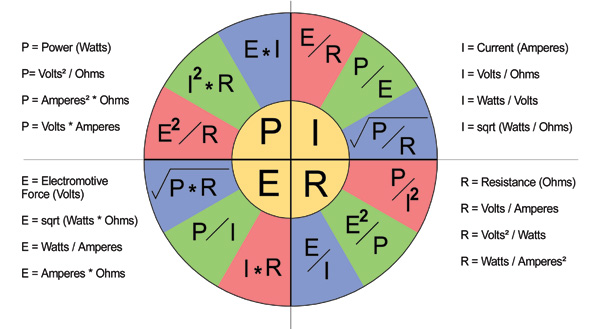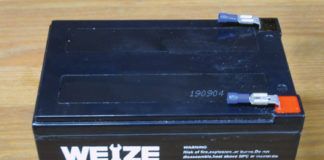
Having played this electronics game since grade school (pre-Sputnik), I sometimes forget when writing this column that not all of us speak electronique as our mother tongue. In particular, I tend to gloss over such trivial items as Ohms Law and Watts Law without giving it a second thought.
Perhaps its time to get back to basics. Georg Simon Ohm (professor of physics, University of Munich, 1852-1854) published a book titled Die Galvanische Kette, Mathematisch Bearbeitet (The Galvanic Circuit, Investigated Mathematically) in which he stated that the relationship between the voltage in a circuit and the current in a circuit was a quantity called resistance. Or, in better mathematical form, R=E/I, where R is the resistance in ohms (Ω), E is the electromotive force in volts, and I is the current in amperes.
This is the fundamental equation of Ohms Law, which isn’t really a law at all, just a mathematical way of expressing what happens in a circuit. It is therefore a definition, but who am I to challenge 150 years of tradition?
Theory to Practice
Lets transfer that to an airplane. When I flick on the pitot heater (which is nothing more than a resistor wrapped around an aluminum tube stuck out in the slipstream), that pitot heater will draw some current. Lets say, just for purposes of illustration, that when I turn on the pitot heat, the ammeter in the airplane shows 3 amps of current and the battery is charged up to 13.6 volts. What is the resistance of that pitot heat resistor? Ohm says that it will be R=E/I or 13.6/3 or about 4.5 ohms, properly written 4.5Ω.
What are some examples of resistors in an airplane? We’ve just discussed pitot heaters. Incandescent light bulbs are a special form of resistor that we will discuss in detail later. Electric motors of every sort (landing-gear motors, fans, even the electric starter can be considered a resistor), as can radios (more about these later also). In short (no pun intended), anything that draws current when you connect it to the battery bus is a resistor.
So what? With a little algebraic manipulation (nothing up my sleeve), we can rearrange Ohms basic law to state that E=IxR (voltage equals current times resistance) and I=E/R (current equals voltage divided by resistance). These three equations are the foundational building blocks of all electronics.
So what does this mean in an airplane? As an example, you know that your landing light is 2Ω, and you want to know what size of fuse to use: I=E/R or 13.6/2 or 6.8 amps. Id probably go with a 10-amp fuse.
But wait. Landing-light requirements are generally specified in watts, rather than ohms. We need Watts law to figure this out.
Watt the?
As the second part of Ohms Law, named for James Watt, the steam engine guy, Ohm told us that the power in a circuit (measured in watts) can be calculated by the formula P=ExI (power in watts is equal to the voltage times the current). Now we can calculate the current and fuse to use if we simply know the wattage of the bulb and the battery voltage. By the same sort of algebraic logic as above, we can say that I=P/I and E=P/I. Or you can use the Ohms Law spreadsheet that is available at www.rstengineering.com/rst/jimsdata/index.html to make the job simply plug and play.
Let’s take the example of a garden variety 4313 landing-light bulb. This bulb is rated at 250 watts at battery voltage. How much current would this bulb draw? Ohm says that it will draw I=P/E or 250/13.6 or 18.4 amperes. A pair of them on at the same time (landing and taxi) would draw 36.8 amps, and Id probably use a 50-amp breaker.
Ohm also told us that one horsepower is equal to 746 watts, so in the example above both lights on at one time would use up (250×2)/746 or about two-thirds of a horsepower. Figuring that the average alternator is about 80% efficient in converting engine power to electricity, it takes nearly a full horsepower just to power the landing/taxi lights!
There are, in fact, 12 equations in the full Ohms Law set, and these are provided in the chart that accompanies this article. They are also available in a form suitable for printing and framing (or insertion into your hangar workbook) at http://faculty.sierracollege.edu/jweir/webpage10/Classlessons/Lesson03.pdf. (Print out Page 4).
Lets talk about light bulbs for a second, especially expensive high-power incandescent bulbs. Lets also back down from that flamethrower 250-watt landing light to a more reasonable (for small aircraft) 100-watt bulb. Now the current is 100/13.6 or 7.4 amps each. Ohm also tells us that R=E/I so the hot resistance (the resistance when the bulb is burning) is 13.6/7.4 or a little less than 2Ω.
However, when its cold (even in Arizona in the daytime in summer) the resistance of an incandescent bulb filament is about 10% of its operating resistance. Lets see now, if the hot resistance is 2Ω, then the cold resistance is something on the order of 0.2Ω. How much current would this draw? We can go back to Ohm, who reveals that I=E/R or 13.6/0.2 or 68 amps. Whoa, doggies, thats a slug of current. However, it only lasts for a few hundred milliseconds (about a quarter of a second), but in that quarter of a second, the bulb is drawing ExI or 13.6×68 or nearly 1000 watts of power. Thats way too much, so what you can do is use the minimum wire size that the FAA charts allow and let that wire be a current limiting ballast resistor for the bulb.
Say, for example, that you use a standard wire table (such as the one available at www.rstengineering.com/rst/jimsdata/index.html) and use 20 feet of #14 wire from the landing-light switch to the bulb. You find that at 68 amps of surge current when you first fire the bulb up, the wire itself will drop nearly 4 volts, giving that landing light bulb a soft start. When the current drops back to 7.4 amps as the filament comes to operating temperature, the voltage drop goes back to about one-third of a volt, not enough to matter. The temperature rise of the wire is also a manageable 5 F over ambient. Need to know more about incandescent lights? The web site at http://members.misty.com/don/bulb1.html#wbt will get you there.
Just as an aside, I was destined to go into electronics from birth. Why? Well, if you have a circuit that has a 1-volt battery and a 1-ohm resistor, W=ExIxR. How about next month we go into the art and science of designing and using voltage regulators? Until then, stay tuned.













